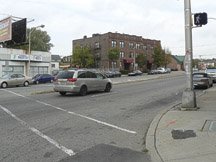Back in May, advocates for Liberty State Park were in an uproar over a proposal by Jersey City officials for a 3.6-mile race track proposed for the park to allow for a Grand Prix Formula One auto race in 2012. The plans were abandoned after much protest.
That idea was only the latest in a series of projects considered over the years for this city, usually involving transportation “improvements,” that never came to fruition because of the magnitude of the project – or they were just beyond rational thought.
Kennedy Boulevard a six lane highway?
To many drivers, Kennedy Boulevard, which stretches from the North Bergen-Fairview border to the end of Bayonne, is akin to a freeway with constant traffic zooming on its four wide lanes north and south.
Imagine if it was a six-lane super highway stretching from doorsteps on one side the road to the other without sidewalks?
That would have been the case if Hudson County political boss John V. Kenny had his way in the 1960s. At that time, Kenny and other Hudson County officials got federal money to radically change the roadway, and could have because the county was responsible for the maintenance of the boulevard.
“I couldn’t believe what I was hearing.” – Dr. Ethel Lawner
________
But the change never happened when residents living along the boulevard got wind of this scheme. Former Jersey City resident Dr. Ethel Lawner, who now resides in Westfield, recalled in a 2006 Jersey City Reporter interview how a police officer’s visit to her Kennedy Boulevard home gave her the scoop on what was to take place.
“He showed these plans to take down the trees and take out the sidewalks in order to make Kennedy Boulevard into a highway,” said Lawner in the interview. “I couldn’t believe what I was hearing.”
Lawner helped create the Save the Boulevard Committee in 1964 with the help of civic activists including Ted Conrad, Morris Pesin, J. Owen Grundy, Audrey Zapp and many others. Soon, the coalition of local housewives, clergy, and teenagers became a force to be reckoned with.
By the end of 1965, plans to create a super highway out of the boulevard failed as the result of litigation in New Jersey State Supreme Court, which dissolved the Hudson County Boulevard Commission that was pushing the highway concept.
Conrad, Pesin and Grundy have passed on and Zapp now makes her home in Colorado. Yet their legacy lives on with the boulevard remaining a humble four-lane highway.
Final destination: Jersey City
Flying into New Jersey on an airplane, you’re going to land at Newark Airport, which has been in business since 1928. But there was a time when planes had another destination to aim for – the Jersey City Airport.
Now the site of the Society Hill residential community on Route 440, the airport opened in May 1929 at a time when Jersey City was gaining prominence in the aviation world.
Jersey City resident Edward Schneider, known as “Eddie the Boy Flyer” was setting flight records like the junior transcontinental record in 1929. Colonel Clarence Chamberlin, a well-known pilot, opened the Crescent Aircraft Corporation in 1928 on Lembeck and Linden avenues in the city’s Greenville section.
Chamberlin advocated an airport for Jersey City, and city officials listened. They negotiated a deal with Jersey City Airports, Inc. to lease 56 of 75 acres of city-owned land at the location known as Droyer’s Point for a total of $320,000 over 25 years. At the airport’s dedication ceremony, Chamberlin said the airports “will be an asset for the city in a few short years.”
But another part of the deal allowed the city the right to take back the land. That option would play a part in the demise of the airfield within a few short years.
In 1935, after Chamberlin spent time as manager of the airport, Schneider became the new manager. His term was brief because that year Mayor Frank Hague chose to move ahead with plans to use federal money set aside for work projects to employ those out of work during the Depression.
The money went toward the construction of a public stadium, Roosevelt Stadium, on the site of the airport. Hague said at the time that he was “meeting public demand,” and Jersey City Airport became a distant memory.
Ricardo Kaulessar can be reached at rkaulessar@hudsonreporter.com.
